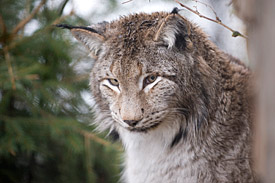Press release from December 11th, 2009
Species distribution models are of only limited value for predicting future mammal distributions
Competition plays a decisive role in climate change adaptation
Leipzig: Species distribution models are of only limited use in predicting the future distribution of mammals. This is the finding of a study of the climate niches of 140 indigenous European mammals. The researchers analysed data on species distribution, climate, land cover and topography, as well as the phylogenetic information of the species. Judging by the large differences in climate niches even for closely related species, mammals seem to adapt fast to changing climatic conditions. This in turn makes predictions based on current distributions unreliable. Writing in Biology Letters, a journal of the British Royal Society, scientists from the Helmholtz Centre for Environmental Research (UFZ) say that since many mammals around the world are endangered by the loss of their habitats and by chemicals and traffic, climate change is just one of many threats.

The Eurasian Lynx (Lynx lynx) is one of 140 European mammalian species, whose climate niches researchers have been studying.
Photo: André Künzelmann/UFZ
In their study, the researchers produced distribution models for European mammals and calculated the climate niche overlap. These show under which climate conditions a species currently occurs. Then they compared the climate niche distance and the phylogenetic distance to the species’ closest relative. The niche overlap was much less than one would have expected from the phylogenetic information. For example, species such as Greater Mouse-Eared Bat (Myotis myotis) and Lesser Mouse-Eared Bat (Myotis blythii), Beech Marten (Martes foina) and European Pine Marten (Martes martes) or Iberian hare (Lepus granatensis) and European Hare (Lepus europaeus) are closely related, but seem to occupy different Climate niches.
"Our analysis points to a high degree of climate flexibility - regardless of phylogenetic distance," explains Dr Carsten Dormann of the UFZ.
"Competition between closely related species has ensured that they currently occupy different climate niches. This does not appear to require
slow evolutionary adaptations, but can be achieved within the physiological constraints of the species. The realized climate niche currently
occupied is therefore probably only a small part of the ‘fundamental’ niche." Mammals can occupy broader fundamental climate niches than
insects or plants because, as endothermic organisms, they are better able to buffer variations in climate:
"We suspect that phylogenetic distance will play a greater role in reptiles and insects." Moreover, the niche overlap is lower among
lagomorphs, rodents and insectivores than among bats and carnivores. This indicates that mobile species are better able to avoid
competition from related species.
Tilo Arnhold
Publication:
Dormann, C.F., Gruber, B., Winter, M., Hermann, D. (2009).
Evolution of climate niches in European mammals. Biology Letters
Weblink
More information
Dr. Carsten Dormann/ Dr. Bernd Gruber/ Dr. Martin Winter
Helmholtz Centre for Environmental Research (UFZ)
Telephone: +49 341 235-1946, -1948 or +49 345 558-5316
Dr. Carsten Dormann
Dr. Bernd Gruber
Dr. Martin Winter
or
Helmholtz Centre for Environmental Research (UFZ)
Press office
Tilo Arnhold
Telephone: +49 341 235 1269
presse@ufz.de
Links
Environmental law and adaptation pressure
In: UFZ Special: On the case of climate change (p.29)
www.ufz.de/index.php?en=10690
At the Helmholtz Centre for Environmental Research (UFZ) scientists research the causes and consequences of far-reaching environmental changes. They study water resources, biological diversity, the consequences of climate change and adaptation possibilities, environmental and biotechnologies, bio energy, the behaviour of chemicals in the environment and their effect on health, as well as modelling and social science issues. Their guiding research principle is supporting the sustainable use of natural resources and helping to secure these basic requirements of life over the long term under the influence of global change. The UFZ employs 930 people at its sites in Leipzig, Halle and Magdeburg. It is funded by the German government and by the states of Saxony and Saxony-Anhalt.
The Helmholtz Association helps solve major, pressing challenges facing society, science and the economy with top scientific achievements in six research areas: Energy, Earth and Environment, Health, Key Technologies, Structure of Matter, Transport and Space. With 28,000 employees in 15 research centres and an annual budget of around EUR 2.4 billion, the Helmholtz Association is Germany’s largest scientific organisation. Its work follows in the tradition of the great natural scientist Hermann von Helmholtz (1821-1894).
